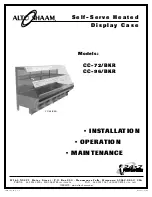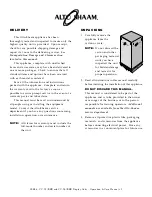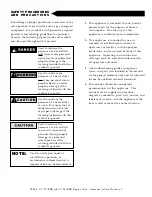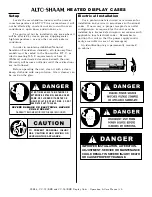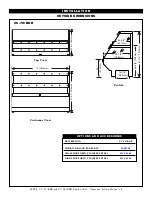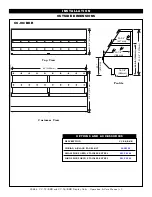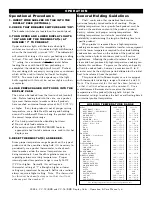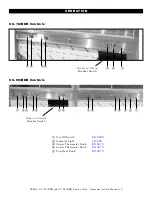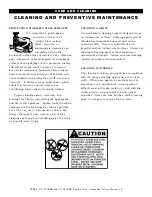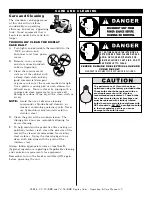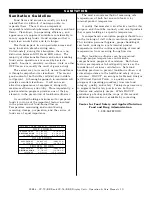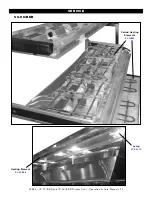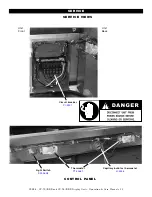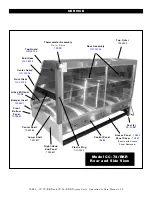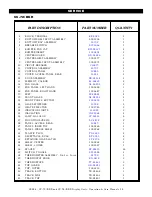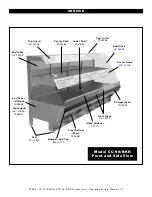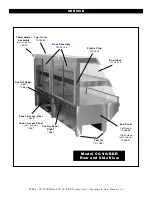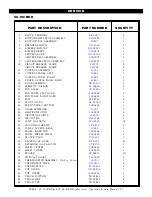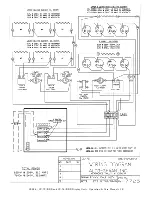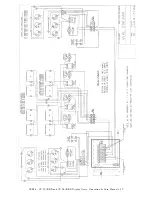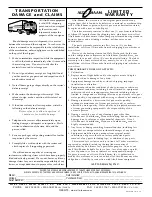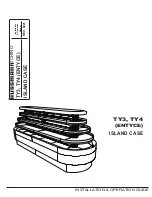
Operational Procedures
1. INSERT WIRE SHELVES OR TILE INTO THE
DISPLAY CASE (OPTIONAL).
2. CHECK THAT BREAKER SWITCHES ARE “ON”.
The breaker switches are located on the control panel.
3. TURN UPPER AND LOWER DISPLAY LIGHTS
“ON” AND SET THE THERMOSTAT(s) AT
NUMBER “7” TO PREHEAT
.
Upper and lower lights will illuminate when light
switches are turned on. An indicator light will illuminate
when the thermostat(s) is turned "ON". The indicator(s)
will remain lit as long as the unit is preheating or calling
for heat. This unit should be preheated, at the number
"7" setting, for a minimum of 30-45 minutes before
loading the case with food. When preheating is
completed, the indicator light(s) will turn off. Preheat
the unit along with any empty serving pans or containers
which will be used to transfer hot foods for display.
NOTE: To ensure better life expectancy of the light
bulbs supplied with this unit, do not overtighten in their
receptacles.
4. LOAD PREPACKAGED HOT FOODS INTO THE
DISPLAY CASE.
The unit can be loaded from the front or back (control)
side. Before loading food into the case, use a pocket-
type meat thermometer to make certain all products
have reached an internal temperature of 160° F (71°C)
or higher. If any food product is not at proper serving
temperature, use a Halo Heat® cooking and holding
oven or Combitherm® Oven to bring the product within
the correct temperature range
.
✔
Use hand protection when handling hot items.
✔
Do not stack food containers.
✔
Be certain only hot PREPACKAGED foods in
appropriate heat tested containers are used in this hot
display case.
5. RESET THERMOSTAT(S) AS NEEDED.
Since proper temperature range depends on the type of
products and the quantities being held, it is necessary to
periodically use a pocket thermometer to check each
item to make certain the correct temperatures are
being maintained. Local health regulations may vary
regarding minimum serving temperatures. Proper
internal product temperature range is usually 160°F
(71°C) or higher. Normally, this will require a
thermostat setting of “7” although a higher or lower
setting may sometimes be required. Self-service sections
always require a higher setting.
Note: The thermostat
for this unit has been factory set so that it will not
advance past the number 9.
General Holding Guidelines
Chefs, cooks and other specialized food service
personnel employ varied methods of cooking. Proper
holding temperatures for a specific food product must be
based on the moisture content of the product, product
density, volume, and proper serving temperatures. Safe
holding temperatures must also be correlated with
palatability in determining the length of holding time for a
specific product.
When product is removed from a high temperature
cooking environment for immediate transfer into equipment
with the lower temperature required for hot food holding,
condensation can form on the outside of the product and
on the inside of plastic containers used in self-service
applications. Allowing the product to release the initial
steam and heat produced by high temperature cooking can
alleviate this condition. To preserve the safety and quality
of freshly cooked foods, however, a maximum of 1 to 2
minutes must be the only time period allowed for the initial
heat to be released from the product.
This particular Alto-Shaam display case is is equipped
with thermostats indicating a range of between 1 and 10.
Note: The thermostat for this unit has been factory set
so that it will not advance past the number 9.
Use a
metal-stemmed thermometer to measure the internal
temperature of the product(s) being held. Adjust the
thermostat settings to achieve the best overall setting based
on internal product temperature.
H O L D I N G T E M P E R A T U R E R A N G E
MEAT
F A H R E N H E I T
C E L S I U S
BEEF ROAST — Rare
140°F
60°C
BEEF ROAST — Med/Well Done
160°F
71°C
BEEF BRISKET
160° — 175°F
71° — 79°C
CORN BEEF
160° — 175°F
71° — 79°C
PASTRAMI
160° — 175°F
71° — 79°C
PRIME RIB — Rare
140°F
60°C
STEAKS — Broiled/Fried
140° — 160°F
60° — 71°C
RIBS — Beef or Pork
160°F
71°C
VEAL
160° — 175°F
71° — 79°C
HAM
160° — 175°F
71° — 79°C
PORK
160° — 175°F
71° — 79°C
LAMB
160° — 175°F
71° — 79°C
POULTRY
CHICKEN — Fried/Baked
160° — 175°F
71° — 79°C
DUCK
160° — 175°F
71° — 79°C
TURKEY
160° — 175°F
71° — 79°C
GENERAL
160° — 175°F
71° — 79°C
FISH/SEAFOOD
FISH — Baked/Fried
160° — 175°F
71° — 79°C
LOBSTER
160° — 175°F
71° — 79°C
SHRIMP — Fried
160° — 175°F
71° — 79°C
BAKED GOODS
BREADS/ROLLS
120° — 140°F
49° — 60°C
MISCELLANEOUS
CASSEROLES
160° — 175°F
71° — 79°C
DOUGH — Proofing
80° — 100°F
27° — 38°C
EGGS —Fried
150° — 160°F
66° — 71°C
FROZEN ENTREES
160° — 175°F
71° — 79°C
HORS D'OEUVRES
160° — 180°F
71° — 82°C
PASTA
160° — 180°F
71° — 82°C
PIZZA
160° — 180°F
71° — 82°C
POTATOES
180°F
82°C
PLATED MEALS
180°F
82°C
SAUCES
140° — 200°F
60° — 93°C
SOUP
140° — 200°F
60° — 93°C
VEGETABLES
160° — 175°F
71° — 79°C
The holding temperatures listed are suggested guidelines only.
#884b - CC-72/BKR and CC-96/BKR Display Units - Operation & Care Manual • 6
O P E R A T I O N

